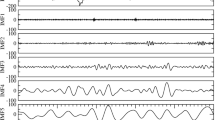Abstract
Studies on extended data including 37 electroencephalographic (EEG) records of δ-sleep, each 103 s long (six subjects; up to seven nights per subject, comprising normal sleep, partial deprivation and recovery), confirmed earlier conclusions that rare episodes of low-dimensional dynamic self-organization, with lifetimes between 10 and 20 s, are present in stage 4 sleep. Particular care was taken of the Theiler correction which, in some δ-sleep signals, required the deletion of trajectory points covering nearly one pseudo-period. The percentage of segments showing an episode, i.e. the attractor probability, decreased with a change in sleep conditions — either deprivation or recovery prior to the next deprivation. Repetition of deprivation over three nights resulted in an adaptation process, manifested by an increase in attractor probability. After the sharp decrease in probability observed when recovery was established prior to the next deprivation, and on return to normal conditions of sleep at 2200 hours, the probability was immediately close to that observed in normal baseline sleep conditions free of any interference. The observation of a definite effect of sleep deprivation and recovery upon the number of stage 4 attractors observed provides a line of approach to the physiological significance of the probability of such attractors.
Similar content being viewed by others
References
Akerstedt T, Gillberg M (1986) A dose-response study of sleep loss and spontaneous sleep termination. Psychophysiology 23:293–297.
Babloyantz A, Salazar M, Nicolis C (1985) Evidence for chaotic dynamics of brain activity during the sleep cycle. Phys Lett A 11:152–156.
Borbély AA, Baumann F, Brandeis D, Strauch I, Lehmann D (1981) Sleep deprivation: effect on sleep stages and EEG power density in man. Electroencephalogr Clin Neurophysiol 51:483–493.
Cerf R (1993) Attractor-ruled dynamics in neurobiology: does it exist? can it be measured? In: Haken H, Mikhailov A (eds) Interdisciplinary approaches in nonlinear complex systems. (Springer series in synergetics, vol 62) Springer, Berlin Heidelberg New York, pp 201–214.
Cerf R, Ben Maati ML (1991) Trans-embedding-scaled dynamics. Phys Lett A 158:119–125.
Cerf R, Ben Maati ML (1995) Attractor characterization from scaled doublet structures: simulations for small data sets. Biol Cybern 72:357–363.
Cerf R, Daoudi A, Khatory A, Oumarrakchi M, Khaider M, Trio JM, Kurtz D (1990) Dynamique cérébrale et chaos déterministe. CR Acad Sci Paris 311 II:1037–1044.
Cerf R, Oumarrakchi M, Ben Maati ML, Sefrioui M (1992) Doublet-split-scaling of correlation integrals in non-linear dynamics and in neurobiology. Biol Cybern 68:115–124.
Grassberger P, Procaccia I (1993) Characterization of strange attractors. Physica D 9:189–208.
Ould Hénoune M, Cerf R (1995) Time reparametrization of phase trajectories as a test for attractor-ruled dynamics: application to electroencephalographic α-waves. Biol Cybern 73:235–243.
Packard NH, Crutchfield JP, Farmer JD, Shaw RS (1980) Geometry from a time series. Phys Rev Lett 45:712–716.
Rapp PE, Zimmerman ID, Albano AM, de Guzman GC, Greenbaum NN, Bashore TR (1986) Experimental studies of chaotic neural behaviour: cellular activity and electroencephalographic signals. In: Othmer HG (ed) Non-linear oscillations in biology and chemistry. (Lecture notes in biomathematics, vol 66) Springer, Berlin Heidelberg New York, pp 174–205.
Rechtschaffen A, Kales A (1968) A manual of standardized terminology, techniques and scoring system for sleep stages of human subjects. Public Health Service, US Government Printing Office, Washington, DC.
Ruelle D (1981) Chemical kinetics and differentiable dynamic systems. In: Pacault A, Vidal C (eds) Nonlinear phenomena in chemical dynamics. (Springer series in synergetics, vol 12) Springer Berlin Heidelberg New York, pp 30–37.
Takens F (1981) Detecting strange attractors in turbulence. In: Rand DA, Young LS (eds) Dynamical systems and turbulence. (Lecture notes in mathematics, vol 898) Springer, Berlin Heidelberg New York, pp 366–381.
Theiler J (1986) Spurious dimension from correlation algorithms applied to limited time series data. Phys Rev A 34:2427–2432.
Toussaint M, Schaltenbrand N, Paiva T, Pollmacher T, Pflieger C, Luthringer R, Macher JP (1994) An architecture for EEG signal processing and interpretation during sleep (ESPIS). Comput Methods Programs Biomed 45:55–60.
Author information
Authors and Affiliations
Rights and permissions
About this article
Cite this article
Cerf, R., Sefrioui, M., Toussaint, M. et al. Low-dimensional dynamic self-organization in δ-sleep: effect of partial sleep deprivation. Biol. Cybern. 74, 395–403 (1996). https://doi.org/10.1007/BF00206706
Received:
Accepted:
Issue Date:
DOI: https://doi.org/10.1007/BF00206706




